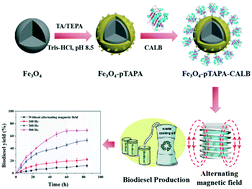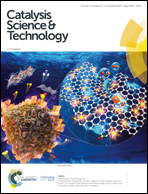Polyamine-induced tannic acid co-deposition on magnetic nanoparticles for enzyme immobilization and efficient biodiesel production catalysed by an immobilized enzyme under an alternating magnetic field†
Abstract
Tannic acid (TA) is a natural polyphenol that has been widely modified on various supporting materials for enzyme immobilization; however, the time-consuming formation of the TA layer and its poor mechanical stability on substrates seriously hinder the practical applications of TA. Herein, we report a facile, rapid and stable enzyme immobilization strategy based on polyamine-induced tannic acid co-deposition on magnetic nanoparticles. Specifically, a tannic acid/polyamine binary system was first deposited and polymerized on the surface of magnetic nanoparticles through a modified mussel-inspired method, and then, an enzyme was immobilized on the formed polymer layer via a spontaneous Schiff-base reaction. The study on the physical properties revealed that polyamine as an intramolecular cross-linker could significantly accelerate the deposition of TA on supports and stabilize the structure of the formed polymer layer. Moreover, CALB, as a representative lipase for biodiesel production, was successfully immobilized on this nanocomposite with a 132.8 mg g−1 support loading capacity and 56.7% activity recovery under optimal conditions. Furthermore, the physicochemical properties of immobilized CALB displayed many significant advantages, including improved pH stability, temperature and methanol tolerance, as compared to those of free CALB. In particular, the theoretical simulation and structural analysis of immobilized CALB demonstrated that this nanocomposite could effectively prevent structural damage to the active pocket of CALB. Moreover, the immobilized CALB exhibited high production efficiency and reusability for further application in the production of biodiesel as compared to free CALB. Interestingly, the immobilized CALB showed very efficient catalytic properties under an alternating magnetic field than the control without an alternating magnetic field, and the reaction rate was enhanced with an increase in magnetic field frequency and strength. Therefore, this polyamine-induced TA co-deposition and polymerization strategy may provide an improved nanoplatform for enzyme immobilization.



 Please wait while we load your content...
Please wait while we load your content...